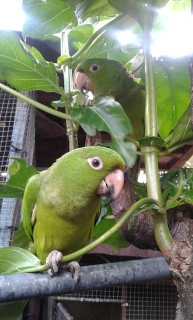Pacific Conure |
|
|
Also known as: Pacific Parakeet, Nicaragua Green Parakeet or Conure
Photos
View in GalleryDid You Know?
The Pacific Conure was once considered conspecific with the Green Conure (Psittacara holochlorus)
Academic Research
Related publications: Psittacara strenuusSpecies Profile
Genus: Psittacara | Species: strenuus
Size:
33cm (13 in).
Weight:
250g.
Subspecies including nominate:
one
Colour Adult:
Both adults mostly green, yellowish on underparts; scattered orange/red feathers on throat and neck of some birds; blue tinge on primary coverts and outer webs of flight feathers; dull yellow/green underwing coverts; dull yellow undersides of flight feathers. Bill horn in colour. Eye ring bare and brown/grey. Eye orange.
Colour Juvenile:
As in adults but with brown eye.
Call:
Calls made in flight are rolling, shrill and harsh; also deeper, stronger notes.
More Information:
Avibase
Research: DNA-sequence data require revision of the parrot genus Aratinga
Content Sources:
Photos
View in GalleryDid You Know?
The Pacific Conure was once considered conspecific with the Green Conure (Psittacara holochlorus)
Academic Research
Related publications: Psittacara strenuusSpecies Care
Captive Status:
Not recorded.
Longevity:
Not recorded.
Housing:
Not recorded.
Diet:
Not recorded.
Enrichment:
Not recorded.
Nest Box Size:
Not recorded.
Clutch Size:
Not recorded.
Incubation Time:
Not recorded.
Fledging Age:
Not recorded.
Hatch Weight:
Not recorded.
Peak Weight:
Not recorded.
Weaning Weight:
Not recorded.
Photos
View in GalleryDid You Know?
The Pacific Conure was once considered conspecific with the Green Conure (Psittacara holochlorus)
Academic Research
Related publications: Psittacara strenuusSpecies Wild Status
World Population:
Unknown, possibly declining.
IUCN Red List Status:
Least Concern (as subspecies of P. holochlorus).
CITES Listing:
Appendix II (as subspecies of P. holochlorus).
Threat Summary:
Not currently considered endangered, however, it has a small range and is poorly known. It appears to once have been numerous in the late 1800s; during the last century it was largely overlooked. Fieldworkers have recently discovered it to be fairly common in Honduras.
Range:
Arid lowlands of Pacific slope from eastern Oaxaca in southern Mexico to inland Guatemala and central Nicaragua.
Habitat:
Found in deciduous, semi-deciduous, evergreen and gallery woodland, Pacific swamp forest, arid tropical scrub, clearings, edge and upland pine-oak formations. Seen in lowlands up to 2600m in Guatemala.
Wild Diet:
Takes Mimosa seeds, Myrica mexicana fruits, and maize recorded. Sometimes raids crops.
Ecology and Behaviour:
Often seen in flight in flocks up to 200 individuals, typically flying higher and with slower wingbeats than similar smaller parakeets. In Nicaragua, flock sizes tend to be larger in the wet season.
Clutch and Egg Size:
Not recorded.
Breeding Season:
Timing unknown; nests are inside rock crevices or cavities in dirt banks, often colonially. Also possibly in tree cavities and termitaria.
Photos
View in GalleryDid You Know?
The Pacific Conure was once considered conspecific with the Green Conure (Psittacara holochlorus)
Academic Research
Related publications: Psittacara strenuusMembers Only Resources
Please log-in now to find more research, resources and tools.
Not a Member?
Find more great information:
Gain exclusive access to 600+ pages of additional research, seminars and podcasts, specialists to ask your toughest questions, and dozens of other fun resources - when you become a WPT member.
Join Today >>

































